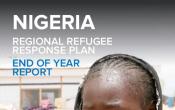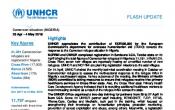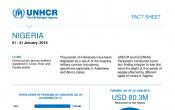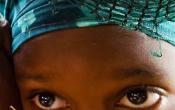Nigeria
Operation: Nigeria
Location
{"longitude":9,"latitude":9,"zoom_level":0,"iso_codes":"'NGA'"}
By clicking on the icons on the map, additional information is displayed.
Key Figures
| 2017 year-end results | |
| 893,170 | people of concern were assisted, the majority of whom (86 per cent) were in areas most affected by the insurgency in Borno State |
| 139,080 | people of concern were provided with legal documentation to prevent protection risks stemming from lack of identification |
| 11,650 | vulnerable people, particularly females heading households, were reached with livelihood interventions |
| 2,940 | people of concern were reached through various protection interventions, including legal representation in court, legal counselling, visits to detention facilities and prisons |
| 2018 planning figures | |
| 100,000 | refugee returnees will be individually registered |
| 20,000 | IDPs with specific needs will receive material support |
| 7,000 | IDPs will receive cash grants |
| 1,200 | refugee returnees will receive production kits or inputs for agriculture/livestock/fisheries activities |
| 30 | community-based committees/groups have been established and will continue to operate in 2018 on SGBV prevention and response |
| 20 | briefings and meetings with donor countries will be conducted |
Latest Updates
People of Concern
| 2016 | 2,911,012 |

[["Refugees",1367],["Asylum-seekers",467],["IDPs",2219272],["Returned IDPs",689906]]
Loading ...
Nigeria
< Back
2017
{"categories":[2013,2014,2015,2016,2017,2018],"budget":[null,null,null,40.906967547,79.767047754,80.40000002],"expenditure":[null,null,null,21.96523424,30.61301372,null]}
{"categories":[2013,2014,2015,2016,2017,2018],"p1":[null,null,null,1.82155943,5.94289722,10.20400001],"p2":[null,null,null,null,null,null],"p3":[null,null,null,2.831582997,30.23548234,22.89000044],"p4":[null,null,null,36.25382512,43.588668194,47.30599957]}
{"categories":[2013,2014,2015,2016,2017,2018],"p1":[null,null,null,1.18809322,2.46861358,null],"p2":[null,null,null,null,null,null],"p3":[null,null,null,1.5415473,15.80133905,null],"p4":[null,null,null,19.23559372,12.34306109,null]}
Loading ...
CHOOSE A YEAR
- 2015
- 2016
- 2017
- 2018
Operational context
Nigeria continued to suffer from the absence of adequate civil administration, police and other law enforcement agencies essential to ensure the rule of law. Large parts of the North East remained under military control. Sustained protection interventions in the midst of hostilities between government forces and the Non-State Armed Groups (NSAG) remained challenging. Commitment of all stakeholders to protect and assist IDPs, complemented by the search for lasting solutions is imperative, as the protection needs of civilians in the North East continued largely unaddressed.In 2017, the counter-insurgency operations in the North East led to a relative improved security. As a result, humanitarian actors were able to access affected populations in new areas. In addition, the Government undertook initiatives to re-construct destroyed infrastructure in areas of return; namely, Bama, Damasak and Monguno. However, access in the newly liberated areas from Boko Haram was limited to the headquarter towns of Local Government Areas (LGAs), where UNHCR’s movement was restricted to safety trenches. Additionally, movement restrictions imposed by the military prevented civilians from pursuing any form of livelihood activities. For these reasons, civilians were restricted to residing in the overcrowded formal camps, where assistance is delivered under the auspices of military forces, thereby constraining the humanitarian space.
Although the improved security situation made it possible for humanitarian actors to access newly liberated areas, restrictions on movement remained. Road movements for UN staff were prohibited, including in key areas of return. Movement to these areas was through UNHAS operated helicopters only. The humanitarian hubs in Gwoza and Ngala were operational, but security remained a concern.
Population trends
In 2017, Nigeria hosted close to 2,000 refugees and some 8,700 asylum-seekers mainly from Cameroon, Democratic Republic of Congo, Central African Republic, Syria and other countries.At the end of 2017, the number of IDP returnees stood at 1.2 million, many of whom returned from various camps and host communities in Maiduguri to locations where infrastructure is damaged and services are not yet restored.
Close to 283,000 Nigerian refugees returned from Cameroon (53 per cent), Niger (47.9 per cent) and Chad (0.1 per cent), of whom 94 per cent were not registered in countries of asylum and returned spontaneously, without UNHCR assistance. However, the most vulnerable and those accessible were assisted upon arrival. Out of the returnees, 51 per cent were women and girls, and 55 per cent were children.
Towards the very end of 2017, Nigeria witnessed the arrival of refugees from Cameroon, following protests within the English speaking Cameroon that had started in October 2016.
Key achievements
In 2017, UNHCR:- Implemented a protection-centered operational strategy, aiming to support the Government and authorities to establish an effective coordination and protection system for refugees, asylum-seekers, IDPs, stateless persons, returnees and other people of concern. A particular emphasis was placed on the protection response to the displacement crisis in the North East;
- As the lead of the protection sector, the office focused on addressing the most serious human rights violations of individuals forced to flee their homes, particularly for the most vulnerable women, children and the elderly. Activities included protection coordination, protection monitoring and screening, community-based protection, community peaceful co-existence and peace-building activities, advocacy on the legal and policy framework, access to justice and legal rights awareness, as well as targeted material assistance and emergency shelter interventions for the most vulnerable;
- Released a strategy on protection, return and recovery for North East together with UNDP, which was presented at the Oslo Conference in February 2017, followed by an action plan to make progress towards durable solutions and contribute to the resilience of affected communities in affected areas;
- Strengthened its protection staff capacity in Borno, Yobe and Adamawa States, which made it easier for communities to report issues and access necessary services;
- Set up mobile courts within two IDP camps to bring justice closer to the people, as well as rolled out a case management system;
- Signed a Tripartite Agreement with the Governments of Cameroon and Nigeria for safe, dignified and voluntary returns of Nigerian refugees from Cameroon to Nigeria. The Tripartite Commission and Technical Working Group are planning a phased approach for voluntary repatriation in 2018;
- Engaged Parliamentarians on the need to domesticate the Kampala Convention for the protection of IDPs through advocacy to the Committee on Refugees, IDPs and Northeast Initiatives in the Nigerian House of Representatives, including through consultation workshops on the finalization of the draft IDP bill;
- Provided emergency response to the Cameroonian refugee influx into the Cross River State.
Unmet needs
UNHCR’s operation in Nigeria was only funded at 40 per cent, resulting in many needs being unmet:- Despite achievements made in 2017, approximately 78,100 internally displaced households continued to reside in poor shelters in camp-like settings and in host communities.
- Despite the significant need for core relief items, UNHCR targeted only the most vulnerable, thus not being able to reach other people in need of such assistance.
- UNHCR was able to start a limited emergency response to the influx of refugees from Cameroon that started in the last quarter of 2017, however, due to scarce resources, most needs were not met.
Working environment
The escalation of conflict in north-eastern Nigeria has triggered displacement within the country and across borders to Cameroon, Chad and Niger. Reports of violations of human rights and international humanitarian law, including sexual violence and exploitation, disappearances, attacks on civilian sites and forced recruitment, are abundant. Insecurity has also had a severe impact on humanitarian needs, as well as on humanitarian access and response.At present, there are more than 5 million people affected by the conflict, including 2,7 million IDPs, over 175,000 returning refugees as well as an estimated 2,000,000 civilians who remain trapped in conflict areas or inaccessible parts of the region. More areas are expected to become accessible as the military recaptures territory and secures civilian locations. Eighty one percent of the IDPs live with host communities putting considerable pressure on their resources..
The majority of internally displaced people (IDPs) are in the states of Adamawa, Borno and Yobe in the North East region. An estimated 90 per cent of displacement is caused by the insurgency, while the remaining 10 per cent results from natural hazards as well as intercommunal clashes. With the recent return of Nigerians from Cameroon and Chad, some of whom have returned to IDP situations the number of IDPs in Nigeria has continued to grow.
In June 2016, the Government of Nigeria, with UNHCR’s support, hosted a Regional Protection Dialogue on the Lake Chad Basin to tackle the worrisome increase in protection incidents, including cases of refoulement. At the close of the Dialogue, the Governments of Cameroon, Chad, Niger and Nigeria pledged to carry out local, national and regional actions to enhance protection and identify potential solutions to displacement.
Led by the Government of Nigeria and supported by the World Bank, the UN and the EU, the North-East Recovery and Peace Building Assessment (RPBA) was launched in 2016 to evaluate the economic, social and physical impact of the conflict in Nigeria. The assessment builds on previous studies and will aim to develop an overarching framework for stability, peacebuilding and recovery.
Key priorities
In 2017, the UNHCR operation will focus on:• Implementing targeted protection services, providing protection-focused material assistance, undertaking shelter and community-based interventions, protection monitoring and advocacy, as well as strengthening of the capacity of local and national authorities to protect IDPs and assist returning IDPs and refugees;
• Pursuing protection and solutions for refugees, IDPs, returnees and stateless persons;
• Preventing and reducing statelessness by building on the outcomes of the Ministerial Conference on Statelessness in February 2015 in Abidjan;
• Supporting the development of a legal, strategic and policy framework regarding the protection and solutions for refugees, IDPs, returnees, stateless persons and other persons of concern through advocacy, capacity-building and technical assistance;
• Enhancing and broadening partnerships with relevant actors, including international non-governmental organizations to ensure that the response to protection and assistance needs is more effective and efficient;
• Strengthening and broadening collaboration with the Economic Community of West African States (ECOWAS) to positively influence subregional policies that incorporate international standards for the protection of displaced populations.




